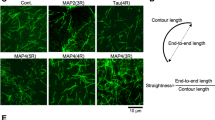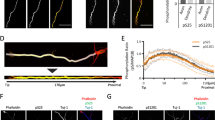Abstract
NEURONS in culture can have fundamentally distinct morphologies which permit their cytological identification and the recognition of their neurites as axons or dendrites. Microtubules may have a role in determining morphology by the selective stabilization of spatially distinct microtubule subsets. The plasticity of a neurite correlates inversely with the stability of its component microtubules: microtubules in growth cones are very dynamic, and in initial neurites there is continuous incorporation of labelled subunits1, whereas in mature neurites, microtubules are highly stabilized2. The binding of microtubule-associated proteins to the microtubules very probably contributes to this stability. Cerebellar neurons in dissociated culture initially extend exploratory neurites and, after a relatively constant interval, become polarized4. Polarity becomes evident when a single neurite exceeds the others in length. These stable neurites cease to undergo the retractions and extensions characteristic of initial neurites and assume many features of axons and dendrites. We have now studied the role of the neuronal microtubule-associate protein tau in neurite polarization by selectively inhibiting tau expression by the addition of antisense oligonucleotides to the culture media. Although the extension of initial exploratory neurites occurred normally, neurite asymmetry was inhibited by the failure to elaborate an axon.
Similar content being viewed by others
References
Okabe, S. & Hirokawa, N. J. Cell Biol. 107, 651–664 (1988).
Horio, T. & Hotani, H. Nature 321, 605–607 (1986).
Mitchison, T. & Kirschner, M. Neuron 1, 761–772 (1988).
Ferreira, A., Busciglio, J. & Caceres A. Devl Bran Res. 34, 9–31 (1987).
Kosik, K. S. et al. Neuron 1, 817–825 (1988).
Goslin, K. & Banker, G. J. Cell Biol. 108, 1507–1516 (1989).
Drubin, D. G. & Kirschner, M. W. J. Cell Biol. 103, 2739–2746 (1986).
Ferreira, A., Busciglio, J. & Caceres, A. Devl Brain Res. 49, 215–228 (1989).
Kosik, K. S. & Finch, E. A. J. Neurosci. 7, 3142–3153 (1987).
Kowall, N. W. & Kosik, K. S. Ann. Neurol. 12, 639–643 (1987).
Jahn, R., Schiebler, W. & Greengard, P. Proc. natn. Acad. Sci. U.S.A. 81, 1684–1687 (1984).
Kosik, K. S., Orecchio, L. D., Bakalis, S., Duffy, L. & Neve, R. L. J. Neurochem. 51, 587–598 (1988).
Tabor, S. in Current Protocols in Molecular Biology Vol. 1 (eds Ausubel, F. B. et al.) 3.10.4–3.10.5 (Wiley, New York, 1989).
Chorey, J. in Current Protocols in Molecular Biology Vol. 1 (eds Ausubel, F. B. et al.) 2.7.1–2.7.5 (Wiley, New York, 1989).
Loke, S. L. et al. Proc. natn. Acad. Sci. U.S.A. 86, 3474–3478 (1989).
Author information
Authors and Affiliations
Rights and permissions
About this article
Cite this article
Caceres, A., Kosik, K. Inhibition of neurite polarity by tau antisense oligonucleotides in primary cerebellar neurons. Nature 343, 461–463 (1990). https://doi.org/10.1038/343461a0
Received:
Accepted:
Issue Date:
DOI: https://doi.org/10.1038/343461a0
- Springer Nature Limited
This article is cited by
-
The evolution of microtubule associated proteins – a reference proteomic perspective
BMC Genomics (2022)
-
Ferroptosis promotes microtubule-associated protein tau aggregation via GSK-3β activation and proteasome inhibition
Molecular Neurobiology (2022)
-
Adenosine receptor signalling in Alzheimer’s disease
Purinergic Signalling (2022)
-
A new non-aggregative splicing isoform of human Tau is decreased in Alzheimer’s disease
Acta Neuropathologica (2021)
-
The Tetramethylpyrazine Analogue T-006 Alleviates Cognitive Deficits by Inhibition of Tau Expression and Phosphorylation in Transgenic Mice Modeling Alzheimer’s Disease
Journal of Molecular Neuroscience (2021)





